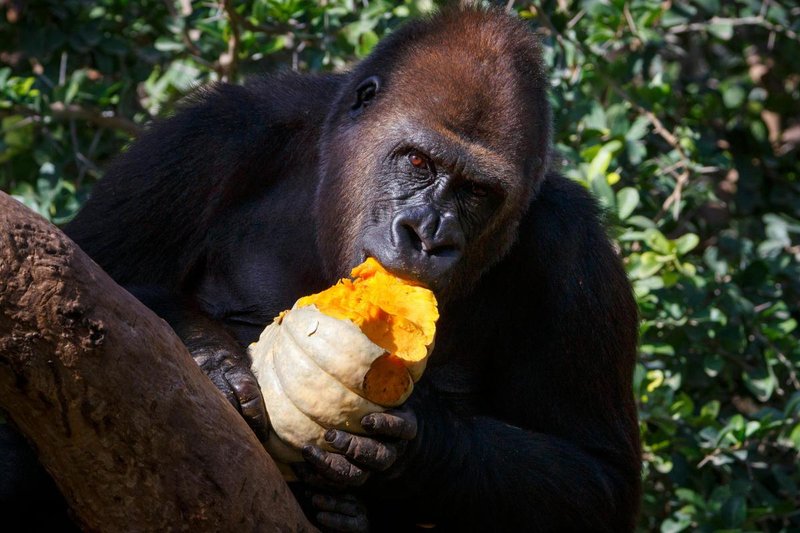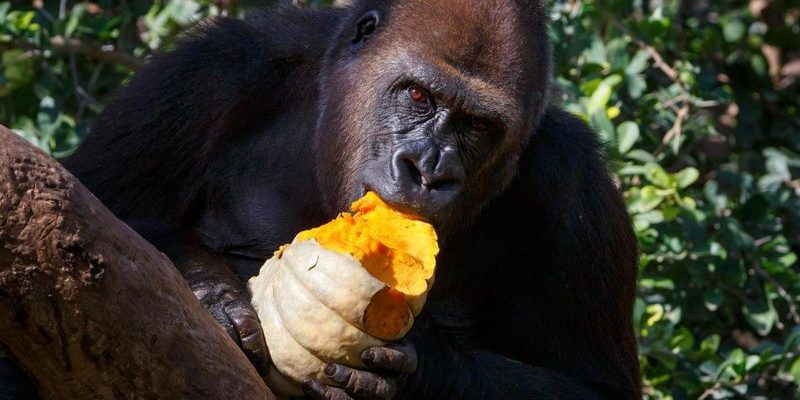
Imagine living in a lush forest filled with a buffet of tasty plants, fruits, and occasionally a protein-packed snack. That’s the life of the western gorilla! They are primarily herbivores, meaning their diet mostly consists of plants. However, they can be opportunistic hunters, showcasing some surprising strategies when it comes to finding food. This article will dive into the details of their diet, hunting methods, and the overall importance of these skills in their survival.
Understanding the Western Gorilla’s Diet
The western gorilla’s diet is primarily made up of foliage, fruits, and flowers. They are known to be quite adaptable, meaning they can adjust their eating habits based on the season and availability of food. Imagine walking through a forest during different seasons—you’d notice that what was once blooming may change over time. Similarly, gorillas navigate their environment, discovering a wide variety of plant life to feast on.
On average, these gorillas consume about 40 different species of plants each day. This variety is essential for their health, ensuring they get a broad range of nutrients. Their strong jaws and teeth allow them to munch through tough leaves and stems, proving that even these gentle giants can tackle rough food. In fact, they are known to eat:
- Leaves and stems
- Fruits and seeds
- Flowers
Interestingly, gorillas have a preference for fruits that are ripe and juicy. They may climb trees to reach their favorite snacks, showcasing their surprising agility. And here’s the thing: they tend to be picky eaters, only opting for the tastiest parts of their food sources.
The Role of Fruits in Their Diet
Fruits hold a special place in the diet of western gorillas. They are like dessert for these massive mammals! Fruits provide essential sugars and energy, fueling their active lifestyle. Gorillas often rely on seasonal fruits, which can change based on the time of year. During certain months, you’ll find them gorging on mangoes, bananas, and various berries.
Because fruits can be scarce when the seasons change, gorillas need to be clever about when and where to find them. They often travel long distances, sometimes covering several miles in search of their next fruity meal. This travel not only helps them find food but also keeps their social groups connected as they move together in search of the best munch spots.
Moreover, fruits are crucial for hydration. In dense jungles, it can be tough to find clean water. Fortunately, many fruits are high in water content, which helps the gorillas stay hydrated. Think of it as nature’s own energy drink—refreshing and tasty!
Hunting Strategies: When Gorillas Go Beyond Plant Eating
While western gorillas are mainly herbivores, they sometimes incorporate protein into their diet. You might be surprised to learn they have hunting strategies, albeit not as aggressive as those of some other predators. Occasionally, they will hunt small animals, such as insects, and this adds a splash of protein to their diet.
Gorillas are not solitary hunters. They often work in groups to gather food. Here’s the fun part: they might communicate through various sounds or gestures, coordinating their efforts to catch these protein-packed snacks. Imagine a team of friends huddled together, strategizing on how to snag the last slice of pizza—it’s a bit like that!
Another interesting tactic is their ability to use tools, though this is a rare sight among gorillas. Some studies have shown that they may use sticks to poke at insects or dig into the ground for hidden snacks. This behavior shows that their intelligence goes beyond just eating; it’s about adapting to their environment and finding clever solutions to food challenges.
Daily Foraging Behaviors
A typical day for a western gorilla involves a lot of foraging. They usually spend about six to twelve hours a day looking for food! This extensive foraging can mean combing through dense foliage, climbing trees, or moving great distances, all while being mindful of their surroundings.
Gorillas are also known to display some interesting social behaviors while foraging. They often share their food with each other, especially mothers with their young. This sharing can be a way to foster social bonds within their groups, making the search for food more of a communal activity rather than a solitary one.
During their foraging sessions, gorillas are also keen on protecting their young. Mothers keep an eye on their babies as they explore, teaching them about safe food choices and the best spots to eat. This nurturing behavior is not just about food; it’s about passing down survival skills for the future!
Impact of Habitat on Diet and Hunting
The habitat of the western gorilla plays a significant role in their diet and hunting strategies. They live in the dense tropical rainforests of Central and West Africa, where the biodiversity is astounding. This rich environment provides them with a wide variety of food options. However, it’s also crucial to recognize that habitat destruction is a pressing issue.
Deforestation, logging, and human encroachment can seriously threaten gorilla habitats. As trees are cut down and areas are developed, these gentle giants lose access to their food sources. You might be wondering how this affects their diet: with fewer fruits and leaves available, gorillas can struggle to find adequate nutrition, leading to health problems and declines in their populations.
Plus, as their habitats shrink, gorillas sometimes have to travel farther for food. This travel can lead to increased encounters with humans, which can be dangerous for them as they face poaching and disease transmission. Protecting their habitat isn’t just about saving trees; it’s about ensuring these magnificent creatures can thrive.
Conservation Efforts and Their Importance
Given the challenges faced by western gorillas, various conservation efforts are underway to protect them and their habitat. Organizations worldwide are working tirelessly to ensure that these animals receive the support they need. This includes establishing wildlife reserves, promoting sustainable land-use practices, and raising awareness about the importance of gorillas in our ecosystem.
Here’s the thing: every little action counts. Supporting anti-deforestation initiatives or responsible tourism can make a difference. When people understand and appreciate these creatures, they’re more likely to take action to protect them.
Additionally, community engagement is crucial in conservation efforts. Local communities play a vital role in preserving habitats while finding a balance between their needs and the well-being of wildlife. By working together, we can create a sustainable future for the western gorilla and ensure they can continue their daily foraging and hunting without fear.
In conclusion, the diet and hunting strategies of the western gorilla reveal much about their lives in the wild. These gentle giants navigate their ecosystems with care, showcasing intelligence and social bonds while seeking food. As we learn more about them, it’s our responsibility to advocate for their protection and ensure their future in the world’s lush forests is secure. By understanding and appreciating their unique ways, we can inspire ourselves and others to contribute to their conservation and the health of our planet.

